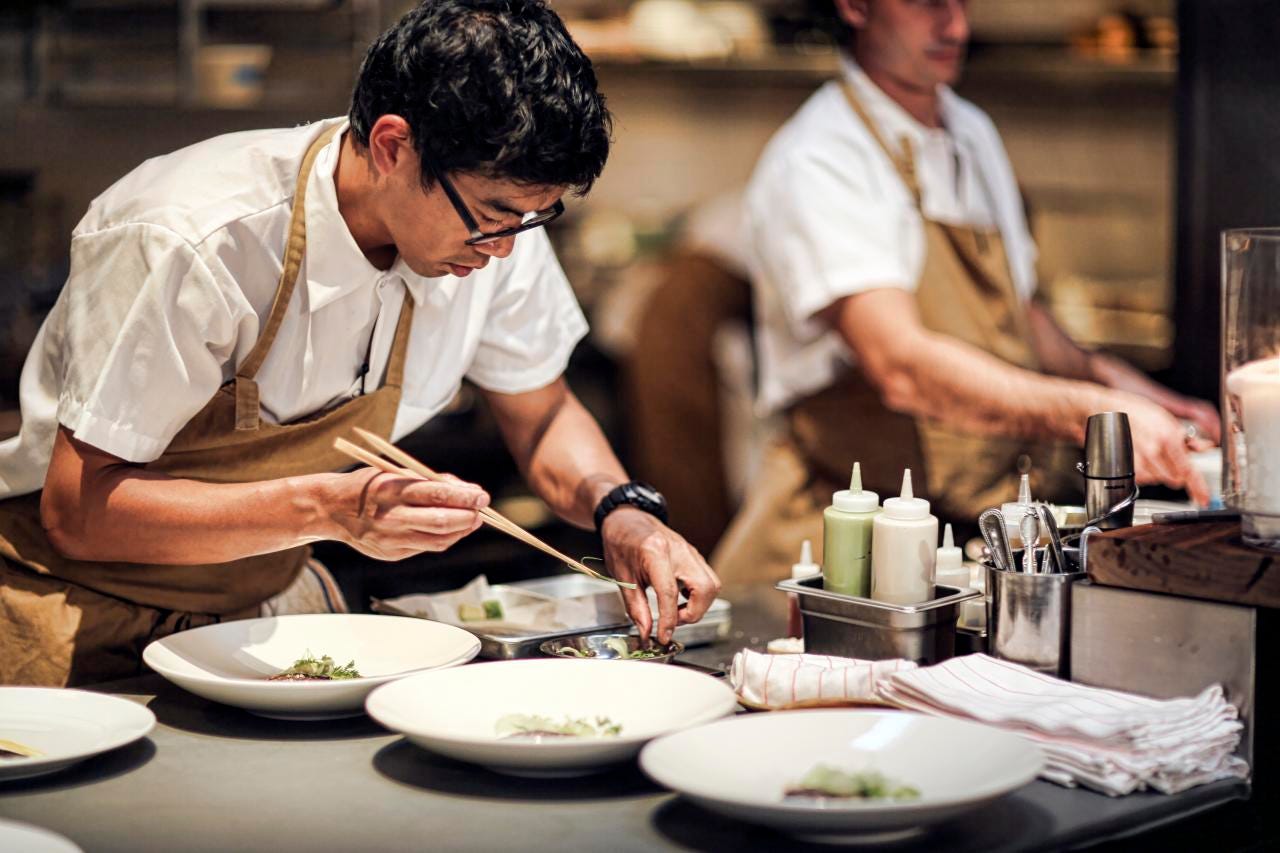
I’m standing at the counter during the post-brunch lull, talking to a regular about whatever fresh idiocy the Trump administration has served up this week. One of the cooks peeks out of the kitchen door, then stands in the doorway for a few minutes, enjoying the fresh air and watching the Warriors game we turned on for the customers. He never steps fully through the door. After a few minutes, he turns around and goes back to the grill, beckoned by the buzz of the small black receipt printer vomiting out a new series of orders for him to prep.
Back at the counter, we continue talking about border walls and racist tyrants.
As servers, we smile and ask how your day is so that we can pay our rent, our student loans and, if we’re lucky, our tickets to Outside Lands. But at its core, tipping is really just fiscal proof of our ability to pass some arbitrary standard of acceptability put in place by the customers.
The service industry functions on the basis of a preassumed power dynamic, where “front of house” workers have approximately five seconds to earn enough respect from the customer to receive a one- or two-dollar reward in the tip jar. Our livelihood is at stake here — as servers, well-entrenched in this system, we smile and ask how your day is so that we can pay our rent, our student loans and — if we’re tippable enough — our tickets to Outside Lands. But at its core, tipping is really just fiscal proof of our ability to pass some arbitrary standard of acceptability put in place by the customers.

And so it makes sense that the walls of bias already entrenched in our day-to-day lives are that much more amplified in the microcosm of the service counter.The customer-server interaction is a fetid cesspool of racism, sexism and more, and restaurants tend to structure themselves around this disturbing privilege-bacteria—specifically when it comes to making hiring decisions over who gets to work “front of house” and who has to work in the back and stay mostly unseen.
The hiring process isn’t solely in the hands of the manager — it’s also in the wallets of the customers. They are, after all, the ones in control of the money flow. The Bay Area especially, with its rapid influx of money, has pushed forth a market forfoodie—i.e., gentrified—dining experiences. Take, for example, Nopalito, an Inner Sunset restaurant that was described by oneZagat revieweras “elevated Mexican food” with an “organic driven” menu and a clientele that is “decidedly not your rice-and-beans crowd.” Let me ask you an honest question: do you think this reviewer would give the same tip to a 40-year-old Latino man as he or she would to a white girl like me? I would hope so, but I have a feeling from their blatantly racist review that the answer would be no.
“If you say anything less than perfect in English and you’re Latina, [customers] think you’re stupid, even if you have an IQ of 140.”
“Front of house” is a pretty obvious delineation — young, cute, female, English speaking and somewhere along the spectrum of whiteness (white or white-passing). Add a septum ring, an Urban Outfitters crop top and a couple of trendy tattoos, and you’ve got pretty much every barista, bartender and waitress from Pacifica to Walnut Creek.
Myself included. Full disclosure — I’m pretty white. Mortified as I am to admit it, I actually once misspelled “pico de gallo” on our specials board. No one noticed for several hours, proving that half the restaurant I experience is just as white as I am. And because of my whiteness, it should not be my perspective that is the voice of this criticism.
So I asked a fellow service-industry survivor, Iza Flores, to talk about her experience with restaurants’ problems of harboring a racial divide in a so-called progressive city. She jumped right to the physical attributes demanded to make one a “qualified” server.
“We servers are expected to be the mermaids, the unattainable mini goddesses”—which, in her words, “sets a precedent.” And so those of us who meet these qualities get propped up in front for strangers to size up and give their money to.
Iza knows a thing or two about borders. She is a bisexual Latina woman who speaks English as her third language, after Spanish and Maya. As a server, in order to achieve the same level of “success” — by which I mean the same tips — as other servers, she admits she takes extra care to enunciate. The anxiety she feels around language at work is strong: “If you say anything less than perfect in English and you’re Latina, [customers] think you’re stupid, even if you have an IQ of 140.” (Meanwhile, I’m over here misspelling “pico de gallo,” and no one says a thing).
Iza is approachable and pretty, with a relatively pale skin tone, so it’s not too difficult for her to build rapport with customers, she says. Yet these relationships don’t come as naturally as they do for her white coworkers, as she still has to deal with the burden of constantly self-examining how she comes across, a conscious switching on and off of her identity and playing up her whiteness depending on the table in front of her. It’s a practice she’s had to take on since she was eight, when she moved to the Bay Area from a Maya reservation in Yucatán. The difference is that now she relies on it for a living.
The service industry, like the Bay Area, is indeed diverse; but that diversity has formed itself into a workplace caste system along racial lines.
A study put out jointly by UC Berkeley and UC Santa Cruz called “Ending Jim Crow in America’s Restaurants” puts numbers to these service-industry subtleties Iza describes. According to the study, Bay Area servers can make up to $180,000 a year with tips at finer dining establishments, whereas “back of house” workers hover around a set salary of $30,000. This is a drastic divide made even more disturbing when compounded by the study’s proof that the servers making the big bucks are overwhelmingly white, while the lower-paying positions are filled primarily by minorities. The service industry, like the Bay Area, is indeed diverse; but that diversity has formed itself into a workplace caste system along racial lines.
“It just makes the segregation more and more pernicious, because we see greater concentrations of people of color in lower-level positions,” says Saru Jayaraman, director of the Food Labor Research Center at UC Berkeley.
I’m young, not skilled enough to cook so much as a scrambled egg and have no familial obligations, and I use my spare money to selfishly fund my own artistic endeavors. Yet my outward appearance means I make significantly more than my back-of-house coworkers, even though we share the same workplace. I’ve sat on the basement steps of the restuarant many times counting out my tips for the night while the night-time cleaner walks past me carrying mops and buckets of bleach. We both know that with that tip money, I am making more than him.
The problem isn’t entirely about which side of the wall one is on, though, but rather about not getting to choose of one’s own accord.
Don’t get me wrong: an economy of tips definitely presents its offenses for front-of-house servers like me. Most notably, I have to be more willing to withstand creepy sexual advances than I normally would if I were just walking down the street. I’m told the imaginary server’s code of ethics says we’re required to be unreasonably polite to all customers. But ultimately, the fact that I was employed specifically because I was deemed “tippable” is itself proof that I’m not the one getting the shorter end of the privilege stick.
The problem isn’t entirely about which side of the wall one is on, though, but rather about not getting to choose of one’s own accord. Iza, whose impressive résumé includes everything from dishwasher to cook to waitress to manager, would much rather be in the kitchen, where she can make money cooking, a skill that she has trained hard for years to master. The high-intensity environment of the kitchen is fun for her but also a challenge, as she describes having to work twice as hard as her male counterparts to earn respect in a space that is generally male dominated. As both a woman and passable as white, proving herself to be less vain and shallow than expected — in other words, the antithesis of the “mermaid” servers out front — is a necessity for acceptance in the back of house. And so she tends to get shuttled up front instead.
It can be overwhelming to navigate these identities and spaces every time she clocks in for a shift, Iza says. Her advice? “Make yourself both as androgynous and unattainable as possible, and be able to withstand the constant interrogation of your marital status.”
One of Iza’s current jobs is with local chocolate company Dandelion, a new advocate for ethical employment and service-training programs in the Bay Area. At Dandelion, all employees are encouraged to work two to three days a week doing front-of-house duties at either the Ferry Building kiosk or the café on Valencia Street, and the rest of the week “back of house” at the manufacturing plant. It’s this model of restaurant “cross-training” that Iza believes will lead the charge toward a more racially inclusive service industry. It also marks a move away from complete dependence on a tip-based system, which preferences white workers over non-white workers because of existing social constructs.
Iza and her partner hope to one day open their own cafe. They want it to be a place with lots of regulars and comedy open-mic nights that employs a racially diverse team of workers trained in all aspects. “Your restaurant, inside and out, should be a representation of what you want to bring to your community,” she says.







